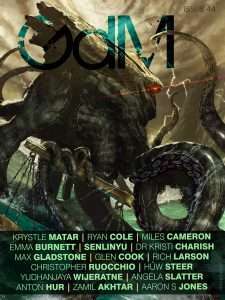All Systems Grimdark
In a recent episode of Fiction Fans Podcast (it’s not a grimdark focused podcast, dear reader, but hear me out) host Lilly explained her way of categorizing books in their genres by identifying the book’s ‘pillars’. For example, a book can have the setting of a sci-fi novel as one pillar, but the pacing and plotline of a thriller novel, and maybe one last pillar of romance to keep it all together. This has been helpful as a way to think about genre mashups and I promptly stole adopted the concept from her.
 The more I ruminate on Grimdark as a genre, the more I begin to apply the pillar concept to the genre itself. As I’ve mentioned in previous articles, Grimdark has a “I can’t define it but I know it when I see it” vibe that will often catch writers off guard. We don’t know we’re writing Grimdark novels until our readers inform us that we have written a Grimdark novel! But over time, I have definitely, probably, maybe, hopefully started to spot some of the aforementioned pillars that hold up the genre as a whole.
The more I ruminate on Grimdark as a genre, the more I begin to apply the pillar concept to the genre itself. As I’ve mentioned in previous articles, Grimdark has a “I can’t define it but I know it when I see it” vibe that will often catch writers off guard. We don’t know we’re writing Grimdark novels until our readers inform us that we have written a Grimdark novel! But over time, I have definitely, probably, maybe, hopefully started to spot some of the aforementioned pillars that hold up the genre as a whole.
My hypothesis about why some books were Grimdark even if the authors didn’t know they had written Grimdark comes down to the ‘pillar’ of worldbuilding. More specifically, it comes down to the systems in place that keep our favourite protagonists on their toes.
In high fantasy staples like Lord of the Rings, the big terrible evil is presented as an anomaly. The world is otherwise more or less good, it’s just that we need to defeat that dude with the big eye in order to restore a status quo of peace and prosperity for our Hobbity heroes. (Yes, I’m aware this is an oversimplification but just stay with me.) The evil, says heroic fantasy, can be stopped. The threat is personified by one person at the head of the big, bad army, and if our heroes topple that threat, our cast is saved from the spreading darkness.
In Grimdark, the darkness and the evil seem to be more firmly established as the status quo. The focus of the story is less about toppling the One Bad Thing and more about surviving the badness that has permeated all that the protagonists know. They strive less to defeat it and more to get around it somehow, or otherwise bend the status quo to their benefit. In this aspect, Grimdark has a lot in common with Dystopian fiction. I would even argue that they both share a common ‘pillar’: they are built on systems that oppress, commodify, exploit, and otherwise make the human (and/or dwarf and/or elf and/or orc) experience as miserable as possible.
As our reality seems to have more in common with Grimdark worldbuilding, I find myself more stubbornly drawn to stories within the genre. It’s well established that I love a flawed and fractured hero, even if the term ‘hero’ is loosely applied to Grimdark protagonists. So too do I find comfort in reading about said ‘heroes’ making their way in flawed and fractured worlds. If their existence is the tooth-and-nail variety—that is, they are fighting for every shred of survival with tooth and nail and whatever other weapons are at their disposal—then it’s easier to see myself in the pages with them. Their existence isn’t cozy, and neither is mine. They are doing their best to scrape some measure of comfort from the system that seeks to grind them into so much dust, and so am I.
If one pillar of Grimdark is that the system is FUBAR, that makes room for the writer to build a story about people defying the broken system to their last breath, and I’ll be damned if that’s not aspirational.
Read Grimdark Magazine Issue #44The post All Systems Grimdark appeared first on Grimdark Magazine.



